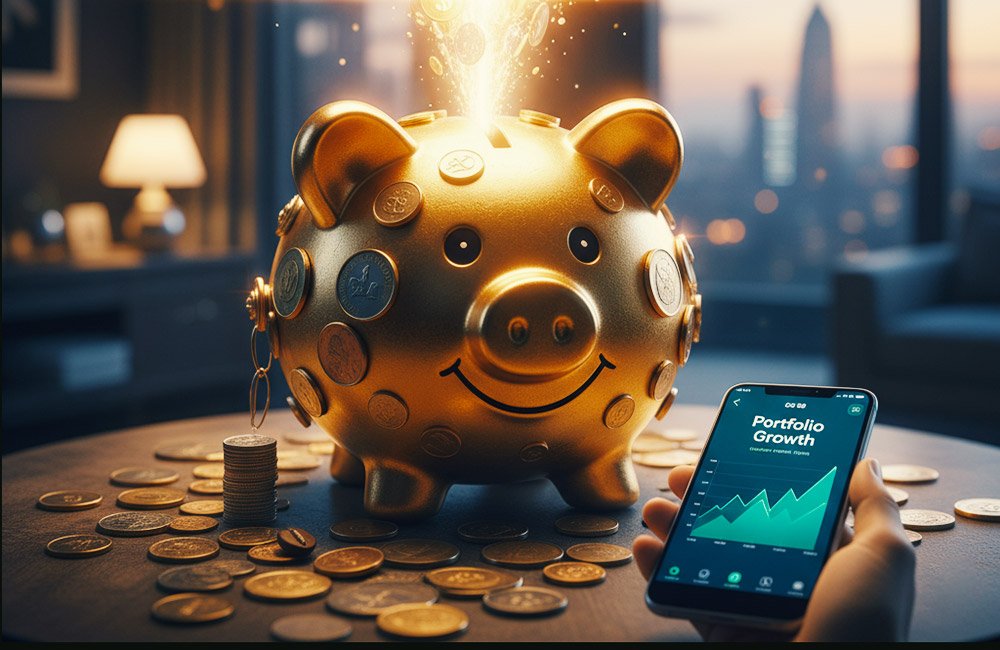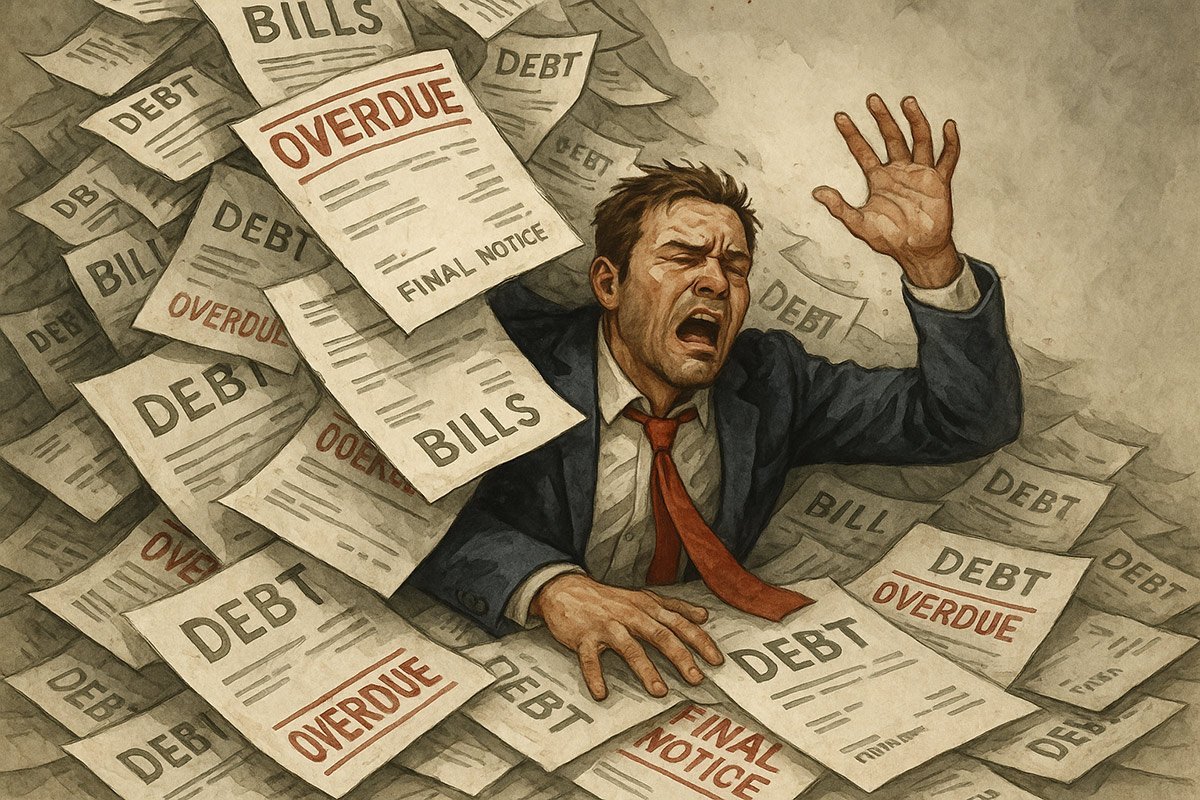Table of Contents
Introduction to Micro-Investing
Remember when your parents told you to save your pennies? Turns out, they were right—they were just thinking too small. Today, all of your spare coins, extra dollars, and more can become powerful tools to create wealth in their own right thanks to a concept called micro-investing. You don’t need tens of thousands of dollars to get started, signing your property to the bank as collateral, or a degree in finance. Many times, in fact, you can begin to grow passive wealth with just a few dollars, if not spare cents, paving the way to financial freedom through a smarter way of spending.
Micro-investing has given wealth building a facelift for the vast majority of the population who previously shied away from one of the most effective ways of generating additional income for the future. Think of it as planting seeds today that will blossom into large trees a few years down the line. Whether you’re still in college, just got the first job on the market, or want to multiply the wealth that you’ve already amassed, micro-investing is the path to follow.
What Makes Micro-Investing Different?
According to traditional investing wisdom, the conventional way to invest money looks like the person standing at the bottom of the massive hill trying to reach its top. The regular way to invest money is exceptionally expensive, making it almost impossible to finance a good portfolio of stocks or currency and funds. An individual can only succeed in their pursuit of becoming wealthy if they are financially stable, which is almost impossible due to the first large step that they have to do to reach up the hill.
The fee structure is also different. Instead of paying commissions on every trade or fee percentages off your returns, many micro-investing platforms charge small, flat-rate monthly fees—usually $1 to $3. This makes investing cheap and accessible, even with small amounts to start.
How It Works
The beauty of micro-investing is simplicity. Most platforms are based on one of two models: round-ups or recurring investments.
Round-up investing is simple. Link your credit or debit card to the app. Every time you make a purchase, the app rounds it to the nearest dollar and invests the rest. Have you purchased coffee for $3.50? The app rounds it to $4.00 and invests the extra $0.50. Those tiny amounts add up to a massively impressive sum.
With recurring investments, you can customize automatic transfers from your bank account. You may choose $5 per week, $20 per two weeks, or $50 per one month. This is a one-time set-and-forget operation.
In the background, your funds are put into a diversified investment portfolio. This is usually made up of exchange-traded funds that own hundreds or thousands of other stocks and bonds. In other words, you’re not betting everything on black.
Popular Platforms That Make It Easy
The micro-investing landscape has exponentially grown with options over the last few years. The best part is that each platform has nearly a similar taste and motive.
Acorns was the first platform to use the round-up model, and it is one of the most popular options up to now. They have three subscription tiers, and the student account is only $3 per month. Besides the saving and investing account, you can save for retirement, open checking accounts, and learn about money more.
Stash makes micro-investing fun and exciting by leveling it up with financial education. This means that one will not only invest in a particular fund or savings but into what shows potential growth. This platform is beneficial because it lets one invest in fractional shares of individual companies. Want to own Apple or Tesla, but they are too expensive? Stash gets you a fraction. The platform fees range from $3 to $9 per month, depending on features.
Robinhood is popular as the company that brought about the revolution of commission-free trading. Although most people know it for more active trading, you can do micro-investing with no account minimum. It also allows one to buy fractional shares and invest spare change without over $1 monthly charges.
M1 Finance is unique in various ways since it allows you to create custom investment portfolios for free. Although slightly complicated, it gives more control. Invest in a “pie” of different investments and rebalance over time.
Betterment, on the other hand, utilizes an automated goal-based investing plan. What are you saving for? Tell it, and it will guide you through the process based on that. Its fee is 0.25% of account balance annually.
The Numbers Speak: Growth Scenarios Over Time
| Time Period | 1 year | 3 years | 5 years | 10 years | 20 years | 30 years |
|---|---|---|---|---|---|---|
| Monthly Contribution | $150.00 | $150.00 | $150.00 | $150.00 | $150.00 | $150.00 |
| Total Contributed | $1,800.00 | $5,400.00 | $9,000.00 | $18,000.00 | $36,000.00 | $54,000.00 |
| Value at 7% Annual Return | $1,865.13 | $5,881.25 | $10,762.88 | $25,933.40 | $73,571.21 | $181,293.07 |
As observed, the numbers get bigger. That is compound interest in action. Even though you will have contributed a total of $54,000 after 30 years, your portfolio will be worth over $181,000. That extra $127,000 is money that came from investment returns and compound growth.
Even if you can only set aside $50 per month, you will be on your way to meaningful wealth. The secret is to get started as soon as possible and make contributions regularly.
Beyond Money: The Other Benefits
Becoming rich is not the only advantage of micro-investing. The other benefits of changing your financial life include:
Accessibility. You do not have to wait until you have saved “enough” to start. You start with what you have now, be it $5.00. This eliminates the most popular excuse most people have for not investing.
Cuts the anxiety of starting. The most challenging part of an exercise regimen is commencing. Micro-investing makes it simple enough so that you hardly see your money leaving. But before you know it, investing will become a regular part of your financial activity.
Involves you in automatic wealth building. Many people find saving the hardest thing to do since they have to spend before saving some amount. But in micro-investing, it compels you to save before your brain realizes it’s money.
Creates learning from experience. Most platforms provide learning material. Nevertheless, the most significant guidance you get is by observing your portfolio’s behavior.
Money stress goes down as your “emergency fund” or safety net grows. It creates a “no-doubt money” that you don’t need to fret. A relatively small investment account feels amazing.
Fractional shares give you a piece of very expensive stocks. Think about companies like Amazon or Google that cost thousands per share. Micro-investing allows you to own $5 worth of any company. This enables diversification across many high-quality investments.
Challenges You Want to Be Aware Of
Fees can be a bigger deal when you have a small amount invested. A $3 monthly charge is 3% of a $100 account but only 0.3% of a $1,000 account. As your account gets bigger, fees aren’t a big deal; early on, they matter. Use platforms without fees or hold off until you can invest more than split up contributions.
Most platforms don’t allow customization. Customization is great, and many traditional brokerage accounts require it. Choose the platform that gives you the ability to pick individual stocks and customize portfolios.
Tax things get complicated. Investment incomes are taxed, and regular small investments can complicate tax reporting. Micro-investing retirement accounts like an IRA help you spend less money on taxes.
Market volatility is a big problem. You’re losing money if the market downturns. While diversity is great, no asset makes money all the time. It’s better to set a long-term goal, not saving for a few weeks.
Your money becomes less accessible. Most micro-investment accounts allow for withdrawal at any time, but frequent withdrawals defeat the purpose of long-term growth.

Smart Strategies to Maximize Your Results
Success with micro-investing isn’t just about getting started. It’s about maximizing your approach.
Stack multiple methods for faster growth. Use round-ups AND recurring investments AND one-time bonuses. When you get a tax refund or birthday money, drop a few bucks into your investment account. That combined approach accelerates wealth building.
Gradually increase contributions as your income grows. Start with $5 weekly, then bump it to $10, then $25. Small increases won’t damage your budget but dramatically change your long-term results. A 10% raise should mean a contribution boost.
Choose the right risk level based on your timeline. If you’re investing for retirement in 30 years, go for aggressive growth portfolios with more stock. If you’re saving for a house down payment in 5 years, choose moderate or conservative portfolios with more bonds.
Don’t check constantly; it fuels anxiety and poor decisions. The market moves up and down every day, but your wealth-building journey happens over years. Don’t check more than monthly or quarterly. Constantly looking will make you prone to panic selling during regular market dips.
Reinvest all dividends to exponentially compound growth. This is automatic on most platforms, but confirm the setting. When you reinvest dividends, your returns make more returns, growing your wealth exponentially over time.
Try to use tax-advantaged accounts. Most micro-investing platforms offer Roth IRAs or traditional IRAs. Use them; they turbocharge your wealth building. Especially if you’re younger, a Roth IRA makes sense.
Who Should Jump Into Micro-Investing Tomorrow
Micro-investing is for several groups of people:
Complete beginners who haven’t invested before. This is perfect for you. The simplicity makes it less scary, and the low minimum removes affordability as a barrier. You can learn the basics of investing for real without much at risk.
Young people in their 20s and 30s have the ultimate financial advantage—time. It doesn’t matter how small their amounts are; decades of compound growth work for young people. For example, if a 25-year-old only puts away $100 monthly, by retirement, they will beat a 40-year-old with just $300 monthly.
Busy professionals who lack the time or energy to research investments can automate this account. Do it once, and technology will do it for you while you keep growing your career.
Those with debt can build wealth at the same time. Ideally, you don’t have to pay off all debt to start investing. Micro-investing equals counteracting debt and assets and comprises a sound financial life.
Parents helping their children to learn about money can use micro-investing as an excellent tool for real-world learning. For example, parents enabling custodian accounts through some platforms give their children the chance to watch their funds grow. It is way more exciting than learning in school and hits home because of the actual money.
How to Set Up Your First Micro-Investment Account
Here’s a step-by-step plan:
1. Choose a platform based on the features and fees – research 2-3 options. Do you want to round up, have automatic contributions, retirement options, or any specific element in the software interface? Read their recent reviews to check the current user experience.
2. Download the app and register your account. This step requires only your personal information, such as your name, address, social security number, and employment info. The process then takes up to 10 minutes. The platform needs to verify your identity to comply with regulations.
3. Link your bank account or your debit card. For recurring investments – link your checking account, and for the roundups – link your spending card. Use the bank’s secure link activation methods and test to verify that it works.
4. Select an investment portfolio. Most often, the platforms will ask you questions about your financial goals, timeline, and risk tolerance. Be honest; these are the questions that determine your investments. Fortunately, you can change it later.
5. Set up your investment method. Enable round-ups if possible. Set recurring transfers that will not hurt your budget. Start small now but increase it later—even $5 weekly is better than nothing.
6. Confirm everything works. Make a small initial deposit to see it works. Watch for a few first round-ups or transfers to ensure they occur. Check the money goes into an investment, not something random.
7. Set a calendar reminder to check your account quarterly. Review your performance along with the total amount of contributions. Check if you can increase the amount of investment too.
The Bigger Picture of Building Real Wealth
Micro-investment is just a start; you will use it to get into the “highway” of ways to build real wealth. As your account grows and you feel more confident in the sphere, you will start using some other strategies. Thus, you will get a traditional brokerage account, business, or real estate. Remember that everything you learn starts with a micro-investment.
The reward is more profound than monetary benefit. You officially become an investor. It changes your attitude toward money, based on the power of future financial position. Also, remember it is a marathon that everyone wins; one will just take less time to achieve the goal.
Want to make studying easier? Check this out: AI for Students – Your Smartest Study Buddy Yet
Align Your Investment Strategy with Your Life Goals
Almost everything may work, as long as it aligns with what you are attempting to achieve.
Short-term objectives are a more suitable idea when placed in a high-yield savings account due to the unpredictability of the market. Market changes might decimate short-term investments since it can be unpredictable. On the other hand, a balanced strategy can be used if your timeline is flexible.
Invest to save money for a vacation or an emergency in the next one to three years. Ideal for house repairs or a new automobile; well-balanced, moderate-risk portfolios are a good fit. A money manager who specializes in short-term investments can weather most economic crises. However, be cautious with such methods.
Medium-term goals – invest to realize things in the next three to 10 years, e.g., to acquire a house, buy a car, or purchase other things. Long-term ambitions are well suited to this approach. A simple strategy. Aggressive portfolios designed for growth. The same applies to long-term investments.
Long-term goals – if it takes over ten years to obtain, go all in! A wonderful place for aggressive portfolios. The time will smooth out the rough edges, and compound multiplication is miraculous. This is the place where micro-investment methods are most effective.
Several accounts may be beneficial. Some enterprises enable you to open several different portfolios with various methodologies to achieve your goals. Separate emergency plans and retirement savings from vacation money; such methods assist you in maintaining effective discipline.
Don’t use it as a piggy bank. Regular withdrawals break the effective work of compounding and may even result in higher taxes. Don’t treat this as everyday spending money. Think of it as a semi-permanent investment that aims to reach the available goal at the time.
Keep increasing contributions. Not increasing contributions loses potential income. Increase your investment rate as you earn more. Your standard of living will increase; on the other hand, if you approach salary raises with a will to save more, wealth will accumulate significantly.
The Future of Micro-Investment and Your Economic Path
The trend will continue, only becoming more comfortable and accessible to everyone. Artificial intelligence, improved automation technology, and micro-investing will undoubtedly continue to evolve. The barriers that have separated simple individuals from wealth planning continue to fall.
However, the main rule will not change. These fundamental elements will be of benefit to both you and your descendants. Micro-investment has nothing to do with speedily increasing your income. This creates financial momentum now, today, with what you have.
If most people are paralyzed by fear, take control of your financial future starting today. And your spare change has no value sitting idle, but with a little time, it can help you create financial security and freedom.
Learn more about how compound interest works to understand the power behind micro-investing.
Take action. Download the app today, connect your card, and watch your spare change turn into real wealth. Your future self is thanking you for your decision right now.

FAQ
Is micro-investing worth it?
Micro-investing is definitely worthwhile, particularly for those who are new to the concept of saving (or to investing) or for people waiting on the sidelines. You won’t turn into a millionaire overnight solely from round-ups, but it establishes the critical practice of investing regularly. The true worth is access—to start with small amounts and learn the investing fundamentals. The more you make contributions, the wealthier you become. People who may have started saving $5 a week now invest hundreds a month because micro-investing gave them the confidence to do so and the knowledge to make informed decisions.
What can I really earn from micro-investing?
Your returns will be based on how much you invest and market performance. Based on historical market returns of 7-10% a year, combined with regular contributions, you could grow $100 a month into more than $150,000 over the course of 30 years. Round-ups alone would net $50 to $150 a month, which could grow to $40,000 to $120,000 over 25 years. It’s all about doing it consistently over time. You shouldn’t expect to get rich quick in this, but over decades you should expect meaningful wealth from it.
How secure and safe are micro-investing apps?
More established micro-investing platforms include bank-level security (with encryption, two-factor authentication and SIPC insurance, which collectively could cover up to $500,000 if the company were to go belly up). Your investments are kept in separate accounts from the company’s operating funds. But all investing, including micro-investing, has market risk: Your portfolio value can decrease. Go for established platforms with good reviews and regulatory compliance.
Do I pay off debt first or start micro-investing?
It depends on your debt type. High-interest debt, like 15 percent to 25 percent credit cards, should usually be paid down before investing, because no investment that exists is guaranteed to return as much as what you’re paying in interest on high-interest debt. But low-interest debt such as student loans (3-6% interest) can be tackled in conjunction with investing. Take a balanced approach: Do the minimum when it comes to debts while doing a small amount of investing. This is how wealth grows while debt gets whittled down, and it makes for superior long-term financial health.
Can I lose money with micro-investing?
Yes. You can lose money because micro-investing uses exactly the same real markets that fluctuate. The value of your account will drop in market downturns. The good news is that diversified portfolios recover over time, and when you micro-invest during dips, you essentially buy shares on sale. The risk of loss decreases significantly over longer time horizons. Generally, you shouldn’t invest any money that you need within 1-2 years. However, investments over 10+ years almost always grow despite short-term volatility.
How much do I need to start micro-investing?
Many platforms have zero minimum; you can quite literally start with $1. Others have minimum initial deposits of $5 or $10. The beauty of it is there’s no “correct” amount. Start with whatever is comfortable, even if it’s just $5 a week. Remember, you can always increase it later. The important thing is to start micro-investing now instead of one day when you “have enough.”
Does micro-investing mean I have to pay taxes on my earnings?
Yes, investments have taxable earnings. Taxes only apply to realized gains—when you sell—and dividends. You will receive tax forms annually for taxable income. However, using Roth IRA accounts in micro-investing platforms lets you not pay taxes on growth and withdrawals in retirement. Traditional IRAs provide tax deductions now but make you pay later. Regular taxable accounts give more flexibility but fewer tax incentives. Pick based on your own situation and needs.






